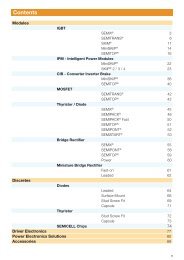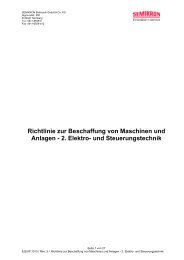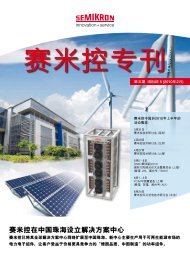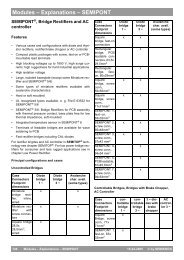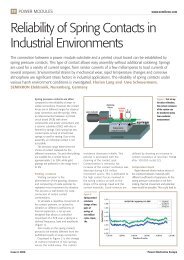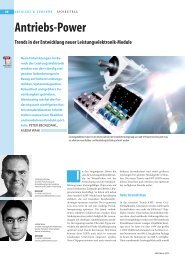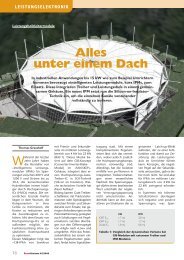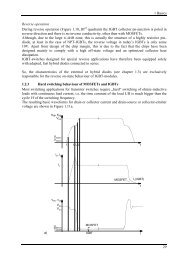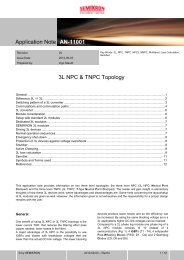Always one step ahead - Semikron
Always one step ahead - Semikron
Always one step ahead - Semikron
Create successful ePaper yourself
Turn your PDF publications into a flip-book with our unique Google optimized e-Paper software.
SKiiP 4 features sintered rather than soldered IGBT`s<br />
and diodes and boasts 4 times the load cycling<br />
capacity, making it far more robust than modules with<br />
soldered connections.<br />
says Thomas Grasshoff, describing the principle.<br />
Every production location is a competence centre<br />
in itself. For example, chip, diode and thyristor<br />
production is in Germany, as is pressure contact<br />
technology, while in Slovakia traditional<br />
baseplate modules are made. Incidentally, at<br />
<strong>Semikron</strong> relocation to other locations is d<strong>one</strong> for<br />
a very simple reason, namely to create space in<br />
Nuremberg for new technologies.<br />
New growth markets<br />
As is the case with many manufacturers of power<br />
electronics, the drives sector plays a major role<br />
for <strong>Semikron</strong> too. This market accounts for more<br />
than 50 percent of the entire power electronics<br />
market worldwide. The cost pressure on this<br />
market is particularly strong, which is why highly<br />
cost-efficient assembly and connection<br />
technologies are needed. In the past ten years,<br />
however, two other sectors have brought about<br />
huge growth on the power electronics market. In<br />
fact, as a result of the ever urgent call for energy<br />
efficiency and energy savings, the areas of<br />
renewables and e-mobility have taken on great<br />
significance. This can be seen at <strong>Semikron</strong>, too.<br />
For example, not only has the number of<br />
employees seen a huge increase over the same<br />
period from 2,000 to 3,200. In fact, this year the<br />
area of renewables is on a par with conventional<br />
powertrains sector as regards turnover figures.<br />
Ruggedness is a must<br />
In the area of renewable energy, <strong>Semikron</strong> is<br />
active on the wind and solar power front. As<br />
much as 20 years ago, <strong>Semikron</strong> was involved in<br />
the production of the first IGBT-controlled wind<br />
power units. This quick move onto this market<br />
has now paid off: around 50 percent of the total<br />
wind power installed globally today features<br />
<strong>Semikron</strong> inverter technology. And the prospects<br />
continue to be good: experts are expecting to see<br />
20-25% growth on the wind power market each<br />
year. Here, the focus is on the expansion of<br />
capacity, on the <strong>one</strong> hand, and technical<br />
improvement, on the other. Reliability is <strong>one</strong> of<br />
the most important criteria for wind power<br />
applications. A further important aspect here is<br />
space, since the inverters are normally installed in<br />
the turbine nacelle.<br />
In the next generation of SKiiP modules,<br />
<strong>Semikron</strong> came up<br />
with an advanced<br />
solution. The<br />
module comprising<br />
driver and power<br />
circuitries and heat<br />
sink offers up to 30<br />
percent more power<br />
density than its<br />
predecessor, thus<br />
Thomas Grasshoff,<br />
Head of Product<br />
Management<br />
SEMIKRON<br />
saving space and<br />
costs. In addition, the<br />
switching losses are<br />
20 percent lower,<br />
meaning more<br />
energy can be<br />
converted. ‘‘As the IGBT’s and diodes are no<br />
longer soldered but sintered instead, SKiiP 4 has<br />
four times the load cycling capacity,’’ explains<br />
product manager Andreas Winterholler. ‘‘This is<br />
why SKiiP 4 modules are far more robust than<br />
soldered modules, which is why the failure rate is<br />
lower’’.<br />
In offshore wind parks, failure is particularly<br />
disastrous, which is why <strong>Semikron</strong> offers an<br />
additional burn-in-test in which the inverters are<br />
tested to their specification limits for 60 and 120<br />
minutes. SKiiP 4 modules include a further<br />
novelty - a digital driver. As a result, fewer<br />
comp<strong>one</strong>nts are needed and the interface is less<br />
sensitive to interference. The use of a diagnosis<br />
50<br />
E & E 08.2010



